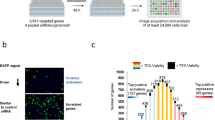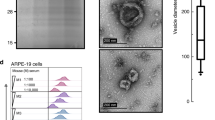Abstract
Human cytomegalovirus (HCMV) is a ubiquitous human herpesvirus that can cause life-threatening disease in the fetus and the immunocompromised host1. Upon attachment to the cell, the virus induces robust inflammatory, interferon- and growth-factor-like signalling2,3,4,5,6,7,8,9. The mechanisms facilitating viral entry and gene expression are not clearly understood4. Here we show that platelet-derived growth factor-α receptor (PDGFR-α) is specifically phosphorylated by both laboratory and clinical isolates of HCMV in various human cell types, resulting in activation of the phosphoinositide-3-kinase (PI(3)K) signalling pathway. Upon stimulation by HCMV, tyrosine-phosphorylated PDGFR-α associated with the p85 regulatory subunit of PI(3)K and induced protein kinase B (also known as Akt) phosphorylation, similar to the genuine ligand, PDGF-AA. Cells in which PDGFR-α was genetically deleted10 or functionally blocked were non-permissive to HCMV entry, viral gene expression or infectious virus production. Re-introducing human PDGFRA gene into knockout cells restored susceptibility to viral entry and essential viral gene expression. Blockade of receptor function with a humanized PDGFR-α blocking antibody (IMC-3G3)11 or targeted inhibition of its kinase activity with a small molecule (Gleevec)12 completely inhibited HCMV viral internalization and gene expression in human epithelial, endothelial and fibroblast cells. Viral entry in cells harbouring endogenous PDGFR-α was competitively inhibited by pretreatment with PDGF-AA. We further demonstrate that HCMV glycoprotein B directly interacts with PDGFR-α, resulting in receptor tyrosine phosphorylation, and that glycoprotein B neutralizing antibodies13 inhibit HCMV-induced PDGFR-α phosphorylation. Taken together, these data indicate that PDGFR-α is a critical receptor required for HCMV infection, and thus a target for novel anti-viral therapies.
This is a preview of subscription content, access via your institution
Access options
Subscribe to this journal
Receive 51 print issues and online access
$199.00 per year
only $3.90 per issue
Buy this article
- Purchase on Springer Link
- Instant access to full article PDF
Prices may be subject to local taxes which are calculated during checkout




Similar content being viewed by others
References
Britt, W. J. & Alford, C. A. Fields Virology 3rd edn (Raven Press, 1996)
Andreoni, K. A., Wang, X., Huang, S. M. & Huang, E. S. Human cytomegalovirus hyperimmune globulin not only neutralizes HCMV infectivity, but also inhibits HCMV-induced intracellular NF-κB, Sp1, and PI3-K signaling pathways. J. Med. Virol. 67, 33–40 (2002)
Boyle, K. A., Pietropaolo, R. L. & Compton, T. Engagement of the cellular receptor for glycoprotein B of human cytomegalovirus activates the interferon-responsive pathway. Mol. Cell. Biol. 19, 3607–3613 (1999)
Compton, T. Receptors and immune sensors: the complex entry path of human cytomegalovirus. Trends Cell Biol. 14, 5–8 (2004)
Netterwald, J. R. et al. Postattachment events associated with viral entry are necessary for induction of interferon-stimulated genes by human cytomegalovirus. J. Virol. 78, 6688–6691 (2004)
Ozato, K., Tailor, P. & Kubota, T. The interferon regulatory factor family in host defense: mechanism of action. J. Biol. Chem. 282, 20065–20069 (2007)
Simmen, K. A. et al. Global modulation of cellular transcription by human cytomegalovirus is initiated by viral glycoprotein B. Proc. Natl Acad. Sci. USA 98, 7140–7145 (2001)
Yurochko, A. D. et al. Induction of the transcription factor Sp1 during human cytomegalovirus infection mediates upregulation of the p65 and p105/p50 NF-κB promoters. J. Virol. 71, 4638–4648 (1997)
Zhu, H., Cong, J. P. & Shenk, T. Use of differential display analysis to assess the effect of human cytomegalovirus infection on the accumulation of cellular RNAs: induction of interferon-responsive RNAs. Proc. Natl Acad. Sci. USA 94, 13985–13990 (1997)
Andrews, A. et al. Platelet-derived growth factor plays a key role in proliferative vitreoretinopathy. Invest. Ophthalmol. Vis. Sci. 40, 2683–2689 (1999)
Loizos, N. et al. Targeting the platelet-derived growth factor receptor alpha with a neutralizing human monoclonal antibody inhibits the growth of tumor xenografts: implications as a potential therapeutic target. Mol. Cancer Ther. 4, 369–379 (2005)
Sandler, C. et al. Imatinib mesylate inhibits platelet derived growth factor stimulated proliferation of rheumatoid synovial fibroblasts. Biochem. Biophys. Res. Commun. 347, 31–35 (2006)
Britt, W. J. Neutralizing antibodies detect a disulfide-linked glycoprotein complex within the envelope of human cytomegalovirus. Virology 135, 369–378 (1984)
Waltenberger, J. et al. Different signal transduction properties of KDR and Flt1, two receptors for vascular endothelial growth factor. J. Biol. Chem. 269, 26988–26995 (1994)
Feire, A. L., Koss, H. & Compton, T. Cellular integrins function as entry receptors for human cytomegalovirus via a highly conserved disintegrin-like domain. Proc. Natl Acad. Sci. USA 101, 15470–15475 (2004)
Cooray, S. The pivotal role of phosphatidylinositol 3-kinase-Akt signal transduction in virus survival. J. Gen. Virol. 85, 1065–1076 (2004)
Wang, X., Huang, D. Y., Huong, S. M. & Huang, E. S. Integrin αvβ3 is a coreceptor for human cytomegalovirus. Nature Med. 11, 515–521 (2005)
Wang, X. et al. Epidermal growth factor receptor is a cellular receptor for human cytomegalovirus. Nature 424, 456–461 (2003)
Cobbs, C. S. et al. Human cytomegalovirus induces cellular tyrosine kinase signaling and promotes glioma cell invasiveness. J. Neurooncol. 85, 271–280 (2007)
Isaacson, M. K., Feire, A. L. & Compton, T. Epidermal growth factor receptor is not required for human cytomegalovirus entry or signaling. J. Virol. 81, 6241–6247 (2007)
Murphy, E. et al. Coding potential of laboratory and clinical strains of human cytomegalovirus. Proc. Natl Acad. Sci. USA 100, 14976–14981 (2003)
Johnson, R. A. et al. Human cytomegalovirus up-regulates the phosphatidylinositol 3-kinase (PI3-K) pathway: inhibition of PI3-K activity inhibits viral replication and virus-induced signaling. J. Virol. 75, 6022–6032 (2001)
English, E. P., Chumanov, R. S., Gellman, S. H. & Compton, T. Rational development of beta-peptide inhibitors of human cytomegalovirus entry. J. Biol. Chem. 281, 2661–2667 (2006)
Gredmark, S. et al. Human cytomegalovirus downregulates expression of receptors for platelet-derived growth factor by smooth muscle cells. J. Virol. 81, 5112–5120 (2007)
Murphy, E. A., Streblow, D. N., Nelson, J. A. & Stinski, M. F. The human cytomegalovirus IE86 protein can block cell cycle progression after inducing transition into the S phase of permissive cells. J. Virol. 74, 7108–7118 (2000)
Boyle, K. A. & Compton, T. Receptor-binding properties of a soluble form of human cytomegalovirus glycoprotein B. J. Virol. 72, 1826–1833 (1998)
Carlson, C., Britt, W. J. & Compton, T. Expression, purification, and characterization of a soluble form of human cytomegalovirus glycoprotein B. Virology 239, 198–205 (1997)
Wang, Z. et al. Recombinant modified vaccinia virus Ankara expressing a soluble form of glycoprotein B causes durable immunity and neutralizing antibodies against multiple strains of human cytomegalovirus. J. Virol. 78, 3965–3976 (2004)
Thomas, B. Viruses and the Cellular Immune Response (Marcel Dekker, 1993)
Huang, E. S., Chen, S. T. & Pagano, J. S. Human cytomegalovirus. I. Purification and characterization of viral DNA. J. Virol. 12, 1473–1481 (1973)
Isomura, H. & Stinski, M. F. The human cytomegalovirus major immediate-early enhancer determines the efficiency of immediate-early gene transcription and viral replication in permissive cells at low multiplicity of infection. J. Virol. 77, 3602–3614 (2003)
Chan, G., Stinski, M. F. & Guilbert, L. J. Human cytomegalovirus-induced upregulation of intercellular cell adhesion molecule-1 on villous syncytiotrophoblasts. Biol. Reprod. 71, 797–803 (2004)
Britt, W. J., Jarvis, M. A., Drummond, D. D. & Mach, M. Antigenic domain 1 is required for oligomerization of human cytomegalovirus glycoprotein B. J. Virol. 79, 4066–4079 (2005)
Shimamura, M., Mach, M. & Britt, W. J. Human cytomegalovirus infection elicits a glycoprotein M (gM)/gN-specific virus-neutralizing antibody response. J. Virol. 80, 4591–4600 (2006)
Li, L., Coelingh, K. L. & Britt, W. J. Human cytomegalovirus neutralizing antibody-resistant phenotype is associated with reduced expression of glycoprotein H. J. Virol. 69, 6047–6053 (1995)
Mar, E. C., Cheng, Y. C. & Huang, E. S. Effect of 9-(1,3-dihydroxy-2-propoxymethyl)guanine on human cytomegalovirus replication in vitro . Antimicrob. Agents Chemother. 24, 518–521 (1983)
Acknowledgements
We thank M. Tallquist for the PDGFR-α knockout mouse fibroblasts, C. Heldin for the human PDGFR-α cDNA, D. Diamond for providing the soluble glycoprotein B, and N. Loizos (ImClone) for the IMC-3G3 antibody. We are grateful to W. Britt (University of Alabama at Birmingham) for viruses, glycoprotein B neutralizing antibodies and discussions. This study was supported by an institutional grant from California Pacific Medical Center Research Institute and by the Arthur Flaming Foundation.
Author Contributions L.S. and A.A. performed experiments; L.S., A.A. and C.S.C. designed experiments, analysed data and wrote the manuscript.
Author information
Authors and Affiliations
Corresponding author
Supplementary information
Supplementary Information
The file contains Supplementary Figures 1-7 with Legends. (PDF 585 kb)
Rights and permissions
About this article
Cite this article
Soroceanu, L., Akhavan, A. & Cobbs, C. Platelet-derived growth factor-α receptor activation is required for human cytomegalovirus infection. Nature 455, 391–395 (2008). https://doi.org/10.1038/nature07209
Received:
Accepted:
Published:
Issue Date:
DOI: https://doi.org/10.1038/nature07209
This article is cited by
-
Viruses exploit growth factor mechanisms to achieve augmented pathogenicity and promote tumorigenesis
Archives of Microbiology (2024)
-
Differentially expressed platelet activation-related genes in dogs with stage B2 myxomatous mitral valve disease
BMC Veterinary Research (2023)
-
ceRNA Network Analysis Reveals Potential Key miRNAs and Target Genes in COVID-19-Related Chronic Obstructive Pulmonary Disease
Applied Biochemistry and Biotechnology (2023)
-
Effect of sorafenib maintenance on Epstein-Barr virus and cytomegalovirus infections in patients with FLT3-ITD AML undergoing allogeneic hematopoietic stem cell transplantation: a secondary analysis of a randomized clinical trial
BMC Medicine (2022)
-
Host Manipulation Mechanisms of SARS-CoV-2
Acta Biotheoretica (2022)
Comments
By submitting a comment you agree to abide by our Terms and Community Guidelines. If you find something abusive or that does not comply with our terms or guidelines please flag it as inappropriate.



